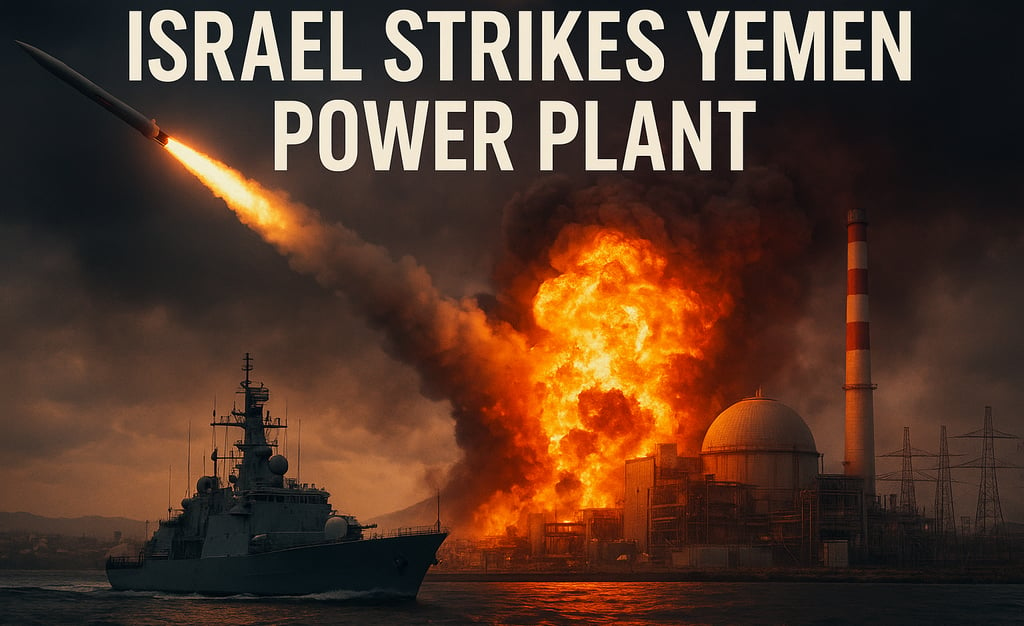Israel Strikes Yemen Power Plant | Why Israel Attacked and Yemen’s Strong Response
Israel attacked Yemen’s Haziz power plant in Sanaa after Houthi drone strikes. Learn why Israel acted, Yemen’s reaction, and the wider Middle East impact.
Raja Awais Ali
8/17/20252 min read


Israel Strikes Yemen Power Plant: Reasons, Yemen’s Response, and Regional Fallout
On August 17, 2025, Israel launched a missile strike on the Haziz power plant near Yemen’s capital Sanaa, marking one of the most serious escalations in the ongoing confrontation with the Iran-aligned Houthi rebels. According to the Israel Defense Forces (IDF), the attack was carried out by Israeli Navy missile boats against an energy infrastructure site that the Houthis were allegedly using to support their military operations. Israel said the strike was a direct response to repeated drone and missile attacks by the Houthis on its territory, assaults that the rebels justify as acts of solidarity with Palestinians amid the Gaza conflict. This incident represents the fourteenth Israeli strike on Houthi-controlled infrastructure since late 2023, reflecting Tel Aviv’s determination to respond to what it views as an expanding Iranian-backed threat. The strike temporarily disabled several power generators at the Haziz facility, leading to blackouts across parts of Sanaa, although firefighting crews managed to contain the blaze and no casualties were reported.
From Yemen’s perspective, the attack was condemned in the strongest terms. The Houthi-run Al-Masirah television described it as “aggression,” while senior official Hezam Al-Asad denounced Israel as a “criminal and bankrupt enemy” targeting civilian infrastructure such as electricity and water systems. The Houthis have long framed their actions against Israel as part of a broader resistance against Western and Israeli intervention in the region, and they argue that attacks on their civilian infrastructure only harden their resolve. In past months, the Houthis have claimed responsibility for targeting Israeli cities and even Ben Gurion Airport with long-range drones and missiles, justifying such actions as retaliation for Israel’s continued military campaign in Gaza.
The broader regional implications of this strike are serious. The Houthis have disrupted international shipping in the Red Sea by attacking commercial vessels, leading the United States and the United Kingdom to conduct joint airstrikes against their positions earlier this year. Israel’s direct involvement, particularly through targeting Yemen’s energy infrastructure, signals that the conflict is expanding beyond the Gaza war and Lebanon’s northern front into the Arabian Peninsula. Analysts warn that such actions risk drawing in additional regional players, further destabilizing global trade routes and energy supplies at a time when tensions in the Middle East are already at a peak. For Israel, the strike underscores its strategy of projecting military power against Iranian proxies wherever they operate, whether in Gaza, Lebanon, Syria, or Yemen. For the Houthis, however, it provides an opportunity to reinforce their narrative as defenders of Palestine and to rally domestic and regional support against what they call Israeli and Western aggression.
In conclusion, Israel’s strike on Yemen’s Haziz power plant highlights the dangerous intersection of the Gaza conflict, Iran’s regional alliances, and the expanding reach of asymmetric warfare. While the immediate damage was limited to temporary power outages, the symbolic significance of targeting vital civilian infrastructure cannot be overlooked. Both Israel and the Houthis appear committed to escalating this confrontation, and unless diplomatic efforts are made soon, the cycle of attack and retaliation could spiral into a wider regional conflict with consequences reaching far beyond the Middle East.